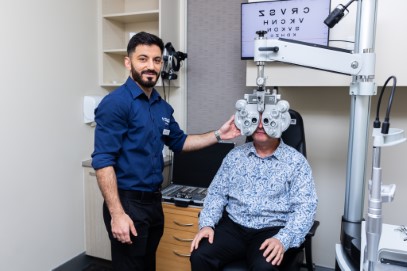Student-led hospital optometry clinic expanded
The University of Canberra (UC) and Canberra Health Services have signed a memorandum of understanding extending Canberra Hospital Eye Department’s student-led optometry clinic.
The arrangement means eyecare for the hospital’s non-acute cases will now be provided by 28 final-year Master of Optometry students under the supervision of UC registered-optometrist educators, said Associate Professor Mei Ying Boon, UC’s discipline lead in optometry and vision science.
The Canberra Hospital optometry clinic opened in 2020 with four consultation rooms, a special instrument room, a dispensing room and a frames room. A recent expansion added four more consultation rooms and another two special instrument rooms. This means there is capacity for 24 daily consultations, allowing more timely and cost-efficient care for patients who do not require ophthalmological intervention, said A/Prof Boon. “Supervised students get to see a high number of patients with pathology or complications due to systemic conditions, which better prepares them for real-world patients with challenging conditions. It also frees capacity for ophthalmology to provide medical and surgical care to those patients who have the most need.” In turn, the hospital’s ophthalmologists provide lectures, workshops and Q&A seminars for the optometry students.

Although hospitals throughout Australia have similar models, albeit tailored to the local community, Canberra’s model differs in the range of patients referred to its student-led clinic, said A/Prof Boon. “All incoming cases for screening of diabetic retinopathy or systemic diseases such as Marfan’s or Wilson’s, ocular complications from medication use or urgent visual fields (post-stroke, assessing fitness to drive) are referred to the student-led UC optometry clinic.”
The Canberra eye clinic also runs advanced, specialty contact lens services for conditions such as keratoconus, myopia control and binocular vision training. It also benefits from speciality clinics for functional and low vision and dry eye, which includes an intense pulsed light (IPL) device, and is in the process of adding virtual reality vision training to its suite of offerings. Anyone can access the clinics, where regular eye tests are free and glasses can be purchased on site. Some services, such as IPL, however, are billable.
The reasons hospitals require this model of optometry support, differ by state, said A/Prof Boon. “Optometrists are regarded as primary care practitioners, so are registered by AHPRA and Medicare. However, depending on a hospital’s payroll system, there may or may not be a clear classification for optometry. Eye department staff in hospitals typically include medical doctors supported by eye nurses and orthoptists, who do not independently diagnose and prescribe.”
The clinic’s success is being evaluated in a 12-month pilot study by A/Prof Boon and colleagues from UC and Canberra Hospital. They hope the research will inform recommendations about how to improve the referral pathway, said A/Prof Boon.


























